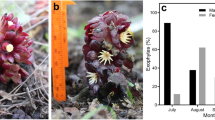Abstract
The flowers ofPavonia cancellata, a creeping ruderal half-shrub of northeastern Brazil, open synchronously at 6:00 h with all anthers already dehisced. The oligolectic beePtilothrix plumata was the most effective pollinator. During 90—180 min, female bees make up to 40 brief pollen collection trips to provision their brood cells. The pollen of about 40 flowers ofP. cancellata is needed to feed one bee larva. The most frequent flower visitors, however, are the specialized curculionid beetlesPristimerus calcaratus, which do not crosspollinate the flowers. They perforate the epidermis with their mouthparts, provoking dehydration, and then actively close the loose petals with their legs. Two hours after opening, half of the flowers had already been closed by the beetles. We interpret the fast, uninterrupted pollen foraging ofPtilothrix plumata bees as a strategy adapted to synchronous pollen presentation ofPavonia and to competition withPristimerus calcaratus: the female bees have to provision their brood cells before the beetles succeed in closing the flowers.
Similar content being viewed by others
References
Alves-dos-Santos I. (1999) Abelhas e plantas melíferas da mata atlântica, restinga e dunas do litoral norte do estado do Rio Grande do Sul, Brasil. Revista Brasileira de Entomologia, São Paulo 43 (3/4): 191–223.
Alves-dos-Santos I. (1999) Notes on bees of the tribe Emphorini (Apidae). Anais do Encontro sobre Abelhas 4 (in print).
Barth O. M. (1975) Catálogo sistemático dos pólens das plantas arbóreas do Brasil meridional XVIII — Malvaceae. Mem. Inst. Oswaldo Cruz 73 (1/2): 1–29.
Bondar G. (1938) Notas entomológicas da Bahia (II). Revta. de Entomologia 8(1–2): 1–24.
Cronquist A. (1981) An integrated system of classification of flowering plants. Columbia Univ. Press, New York, 1262p.
Cruden R. W. (1977) Pollen-ovule ratios: a conservative indicator of breeding systems in flowering plants. Evolution 31: 32–46.
Gimenes M. (1991) Some morphological adaptations in bees (Hymenoptera, Apoidea) for collecting pollen fromLudwigia elegans (Onagraceae). Revta. bras. Ent. 35(2): 413–422.
Gottsberger G. (1972) Blütenbiologische Beobachtungen an brasilianischen Malvaceen. II. Österr. Bot. Z. 120: 439–509.
Grant V., Hurd P. D. Jr. (1979) Pollination of the southwestern Opuntias. Plant Syst. Evol. 133: 15–28.
Krapovickas A., Cristóbal C. L. (1962) Notas sobre la secciónLebretonia, Pavonia, (Malvaceae) y revisión de las especies Argentinas. Lilloa 31: 5–74.
Linsley E. G., MacSwain J. W., Michener C. D. (1980) Nesting biology and associates ofMelitoma (Hymenoptera, Anthophoridae). University of California Publications in Entomology 90: 1–39.
McFarland J. D., Kevan P. G., Lane M. A. (1989) Pollination biology ofOpuntia imbricata (Cactaceae) in southern Colorado. Can. J. Bot. 67: 24–28.
Michener C. D., McGinley R. J., Danforth B. N. (1994) The bee genera of North and Central America (Hymenoptera: Apoidea). Smithsonian Institution, Washington, 209p.
Neff J. L., Simpson B. B. (1993a) Bees, pollination systems and plant diversity. In: LaSalle J., Gauld I. D. (eds.) Hymenoptera and Biodiversity. CAB International, Wallingfor, UK.
Neff J. L., Simpson B. B. (1993b) Partial bivoltinism in a ground-nesting bee: the biology ofDiadasia rinconis in Texas (Hymenoptera, Anthophoridae). J. Kansas Entomol. Soc. 65(4): 377–392.
Osborn M. M., Kevan P. G., Lane M. A. (1988) Pollination biology ofOpuntia polyacantha andOpuntia phaeacantha (Cactaceae) in southern Colorado. Plant Syst. Evol. 159: 85–94.
Paraíba, Governo do Estado. Universidade Federal da Paraíba (1985) Atlas geográfico do Estado da Paraíba Grafset, João Pessoa, 100p.
Pinheiro M., Schlindwein C. (1998) A câmara nectarífera deIpomoea cairica (L.) Sweet (Convolvulaceae) e abelhas de glossa longa como polinizadores eficientes. Iheringia Sér. Bot. 51(1): 3–16.
Porsch O. (1929) Vogelblumenstudien II. Jahrb. wiss. Bot. 70: 181–277.
Roubik D. W. (1989) Ecology and natural history of tropical bees. Cambridge University Press, New York, 514 pp.
Roubik D. W., Moreno J. E. (1991) Pollen and spores of Barro Colorado Island. Monographs in Systematic Botany, Missouri Bot. Grds. 36: 1–270p.
Schlindwein C. (1995) Melittophilous plants, their pollen and flower visiting bees in Southern Brazil. 2. Cactaceae. Biociências 3(2): 35–71.
Schlindwein C. (1998) Frequent oligolecty characterizing a diverse bee-plant community in a xerophytic bushland of subtropical Brazil. Stud. neotrop. Fauna & Environm. 33: 46–59.
Schlindwein C., Wittmann D. (1995) Specialized solitary bees as effective pollinators of South Brazilian species ofNotocactus andGymnocalycium. Bradleya 13: 25–34.
Schlindwein C., Wittmann D. (1997) Stamen movements in flowers ofOpuntia (Cactaceae) favour oligolectic bee pollinators. Plant Syst. Evol. 204: 179–193.
Wibmer G. J., O'Brien C. W. (1986) Annotated checklist of the weevils (Curculionidae sensu lato) of South America (Coleoptera: Curculionidae). Memoirs of the American Entomological Institute 39: 1–563.
Author information
Authors and Affiliations
Rights and permissions
About this article
Cite this article
Schlindwein, C., Martins, C.F. Competition between the oligolectic beePtilothrix plumata (Anthophoridae) and the flower closing beetlePristimerus calcaratus (Curculionidae) for floral resources ofPavonia cancellata (Malvaceae). Pl Syst Evol 224, 183–194 (2000). https://doi.org/10.1007/BF00986342
Received:
Accepted:
Issue Date:
DOI: https://doi.org/10.1007/BF00986342




